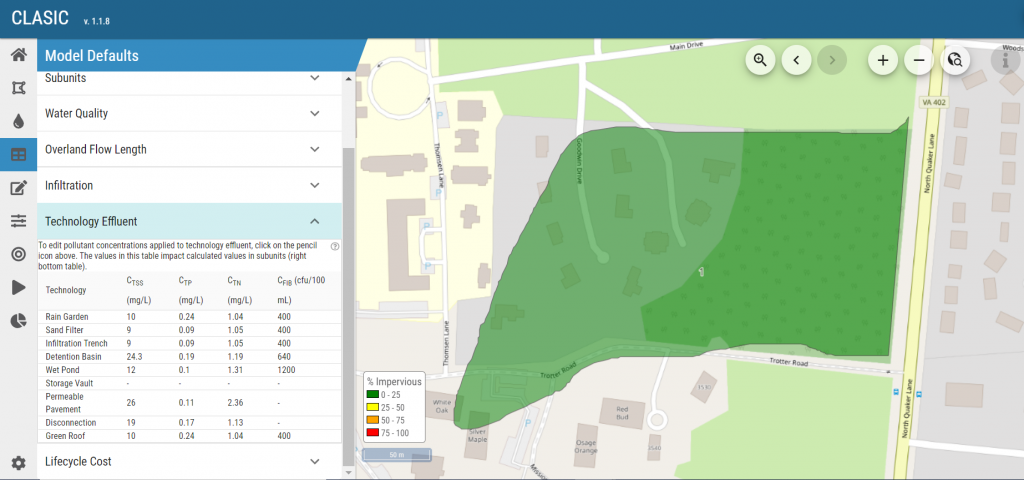Stormwater project designers often have numerous design and configuration options that would match the parameters of a project site. Their challenge becomes identifying the options that will provide maximum environmental, social, and economic benefits at minimal costs.
A new decision-support tool developed by the Water Research Foundation (WRF; Denver) aims to make that challenge easier. WRF’s Community-enabled Lifecycle Analysis of Stormwater Infrastructure Costs (CLASIC) tool, released in April, lets users weigh the long-term pros and cons of different infrastructure designs. Using climatological, geographic, and historical data, the free tool also enables users to quantify factors beyond stormwater management such as community co-benefits and climate-change resilience.
“This is the culmination of a multi-year effort to provide stakeholders with powerful tools for comparing the costs and benefits of stormwater infrastructure alternatives,” said Peter Grevatt, WRF Chief Executive Officer in an April release.
Providing Actionable Data
CLASIC users begin by defining their project area. Using built-in geographic information system (GIS) capabilities, they identify such site-specific factors as percentage of impervious surface area, soil types, and slope. Next, they can access relevant information from such sources as the U.S. Census, the National Land Cover Database, and the U.S. Environmental Protection Agency (EPA) BASINS Model to provide a baseline for the defined project area’s climatological and hydrological conditions. Optionally, CLASIC can incorporate international-standard climate change scenarios to consider how infrastructure built today could perform differently tomorrow.
From there, users can model a range of both green and gray infrastructure — rain gardens, infiltration trenches, permeable pavement, underground storage tanks, and more — appropriate for the site. CLASIC can recommend interventions to prioritize specific targets, such as pollution reduction, regulatory compliance, and life-cycle costs.

Unique to the CLASIC tool is its ability to estimate and quantify the co-benefits of new infrastructure. This feature facilitates comparison between important factors such as mental health benefits, improved biodiversity, and urban-heat mitigation, which are often qualitative. Each modeled scenario assigns a score out of five points that measures the environmental, social, or economic improvements of new infrastructure compared to current conditions. The user has the option to prioritize infrastructure recommendations based on specific co-benefits.
CLASIC has been in production since 2016, funded by a nearly $2 million U.S. EPA grant. In addition to WRF, stormwater experts from several U.S. universities, engineering firms, and nonprofits — including the Water Environment Federation (Alexandria, Virginia) — contributed to the tool’s development.
Real-World Applications
CLASIC’s early adopters already are reporting its usefulness as a decision-support tool.
In Kansas City, Missouri, city engineers used CLASIC to optimize their plans for a series of 62 rain gardens each covering about 93 m2 (1,000 ft2) on recently vacated urban lots. A case study about the project describes that users wanted to determine whether the potential benefits associated with including two trees in each rain garden would justify their implementation costs. According to CLASIC’s estimations, including the trees would more than double infiltration rates and halve runoff, compared to tree-less gardens. Although adding trees entails significant upfront costs, the case study describes, their addition cuts the cost of reducing 0.45 kg (1 lb) of phosphorus in half from $0.22 without the trees to $0.11 with them. Including trees also would notably increase co-benefit scores, according to the analysis.
Using CLASIC’s climate-change modeling capabilities, planners in San Diego wanted to determine whether three new 2,830-m3 (100,000-ft3) detention basins would remain cost-effective under a potential scenario. In this drier and hotter scenario, the city would receive 15% less annual precipitation and face 10% higher evaporation rates. According to the tool’s output, this climate would increase the life-cycle costs of the basins by about $90,000 due to more frequent irrigation needs.
In current conditions, the basins would increase rainfall infiltration rates by about 10%, helping replenish local groundwater. In the hot-and-dry scenario, however, they would reduce infiltration and potentially undermine the area’s groundwater supplies.
CLASIC helped project planners understand that the basins were too sensitive to shifts in precipitation patterns, and therefore not an ideal approach for the site, a case study about the project describes.
Users in Fort Collins, Colorado, wanted to deploy enough green infrastructure to prevent street flooding during a 25-mm (1-in.) rainfall event. They tested three scenarios using CLASIC.
First, they modeled a 0.8-ha (2-ac) pond in their project area. It was predicted to capture approximately 8,500 m3 (300,000 ft3)of runoff and reduce total suspended solids (TSS) by 15%.
Second, they simulated a decentralized approach that would install 38 sand filters, 57 rain gardens, and permeable pavement. The decentralized approach resulted in a slightly higher runoff-capture capacity in addition to decreasing both TSS and runoff generation by about 50% while increasing infiltration rates by 20%.
Third, they considered a mixture of both, featuring a smaller pond alongside permeable pavement, 19 sand filters, and 4 rain gardens. The hybrid option was projected to reduce TSS by 30% and runoff by 15%.
Although CLASIC estimated that the second option would provide superior stormwater management performance by a wide margin over other options, it also showed that the decentralized approach would be more than nine times as expensive over the next 35 years as the pond-only option and more than twice as expensive as the hybrid option. The hybrid option — at less than half the life-cycle cost of the decentralized approach — turned out to be the most cost-effective option, project documents describe.
Access the new CLASIC tool for free at https://clasic.erams.com/.
Top image courtesy of Free-Photos/Pixabay





